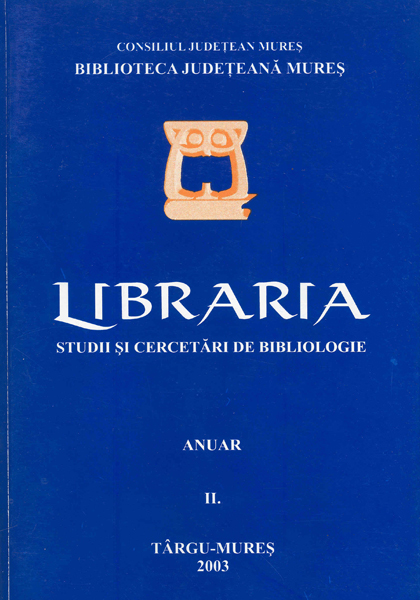Informaţii geografice într-o carte de secol şaptesprezece
Geographical Informations in a Book from the 17th Century
old book
Author(s): Luana TROIASubject(s): Museology & Heritage Studies, Library and Information Science, Other
Published by: Biblioteca Județeană Mureș
Keywords: Libraria; Biblioteca Județeană Mureș; biblioteconomie; bibliologie; carte veche; carte bibliofilă; istorie locală; servicii de bibliotecă; Biblioteca Teleki; carte veche românească;
Summary/Abstract: There are not so many informations about the history of geography in our librairies. That is why we consider that any ancient book might offer some clues in this way.From this point of view, one of the most valuable books could be Breve compendium nationis gloriosae totius Linguae Illyricae; in quo breviter origo ipsius nationis ostenditur, extensio eius copiosa; reges fidei catholicae totius Dalmatiae, Bosniae, Serviae, atque Rassiae, quos habuit; in fine vero sub umbra Aquilae magnarum alarum Respublica Ragusi na feliciter quomodo moratur, printed in 1683. It is an engravings collection that contains images of the most important towns all over the world, but especially from Europe. The artists – Rosa Martinus Sebenicensis and Fra Valeggio Francisco – tried to show the process of development of towns, during the Middle Age.Each engraving is completed by some notes, in Latin, that give us informations about the geographical position of the town. Unfortunatelly, they do not put down the year the town looked like at. In our days, the specialists consider that it is about the period between the first decade of the 15th century and 1593.According to these images, we can better observe the evolution and also the changes of topographical situation of towns. When they had enough informations, the artists gave us more than one representation of towns; Rome, for example, has two engravings: one from ancient times, with the inscription Roma antiqua; the other dates from the 16th century.But we can not find only the ancient images of the most important and large towns; we may also observe engravings of some small towns, that could have hardly been identified. Some of them are today lost.The engravings are not arranged in alphabetical order of the towns they represent and they seem to be quite mixed up; more than that, the book cover is made from vellum and it seems to be a later binding. Therefore, it is possible for this book to have its own history, along with the history it contains.
Journal: Libraria. Studii și cercetări de bibliologie
- Issue Year: II/2003
- Issue No: 2
- Page Range: 198-203
- Page Count: 6
- Language: Romanian

